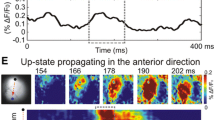Abstract
The influence of the medial septal nucleus and the nucleus of the diagonal band of Broca (MS-DB) on the hippocampal theta rhythm includes both cholinergic and γ-aminobutyric acid (GABAergic) components. To understand the intrinsic septal interactions and the separate contributions of the cholinergic and GABAergic septohippocampal neurons to the theta rhythm in behaving animals, it is essential to be able to identify these two classes from extracellular recordings. Here the durations of extracellularly recorded action potentials are compared with the other characteristics of the neurons. Extracellular recordings were taken from neurons of the MS-DB both in freely moving rats (114 cells) and in urethane-anesthetized rats (112 cells). These were compared with intracellular recordings taken from MS-DB neurons in urethane-anesthetized rats (58 cells). Hippocampal EEG was recorded from above the CA1 pyramidal cell layer (CA1 theta) and near the hippocampal fissure (dentate theta) to compare the firing phase across cells. Here it is shown that two major types of rhythmically bursting cells in the MS-DB that had been distinguished previously in intracellular recordings in vivo are also separable in extracellular recordings in vivo on the basis of the durations of their action potentials. In both awake and anesthetized rats the main properties of the two cell types were found to differ: firing rate, phase-relation to the hippocampal theta rhythm and sensitivity of their rhythmicity to blockade of muscarinic transmission. As was previously shown for intracellular recordings in anesthetized rats, it is shown here that in awake rats, too, the more rapidly firing brief-spike (putative GABAergic) cells fired with highest probability on the negative phase of the dentate theta, whereas the more slowly firing long-spike (putative cholinergic) cells fired mostly on the positive phase. Previous work showed that in intracellular recordings from anesthetized rats the rhythmic firing of most brief-spike cells was still retained even during muscarinic blockade, but that of most long-spike cells was lost. Here we also report a recategorization according to spike duration of existing extracellular recordings taken from anesthetized rats, confirming the above observation with much larger numbers of cells. Three additional major new findings are also reported here. (1) In awake rats, muscarinic blockade has relatively little effect on either cell type. (2) Under anesthesia, the firing rates of both cell types are lower than in awake rats, but the effect is greater on the long-spike cells, where the anesthesia also reduces the rhythmicity of the cell firing. (3) Rhythmicity of the putative GABAergic cells is also retained after local injection of GABA-A antagonist, whereas that of the putative cholinergic cells is eliminated. We conclude that either systemic muscarinic blockade or urethane anesthesia alone have relatively little effect on neurons in the defined above MS-DB, but a combination of the two has profound effects on the rhythmicity of the cholinergic cells, largely sparing the GABAergic cells. Taken together, the results suggest that generation of theta rhythm requires a background of excitatory influences on the hippocampus (that can be maintained by either muscarinic or glutamatergic inputs) in combination with the phasic disinhibitory action mediated by the GABAergic MS-DB projection. They also provide additional support for the notion that the phasic activity in local collaterals of GABAergic MS-DB cells contributes to the phasic modulation of the firing of cholinergic septohippocampal neurons.
Similar content being viewed by others
Author information
Authors and Affiliations
Additional information
Received: 13 October 1998 / Accepted: 15 March 1999
Rights and permissions
About this article
Cite this article
Brazhnik, E., Fox, S. Action potentials and relations to the theta rhythm of medial septal neurons in vivo. Exp Brain Res 127, 244–258 (1999). https://doi.org/10.1007/s002210050794
Issue Date:
DOI: https://doi.org/10.1007/s002210050794




